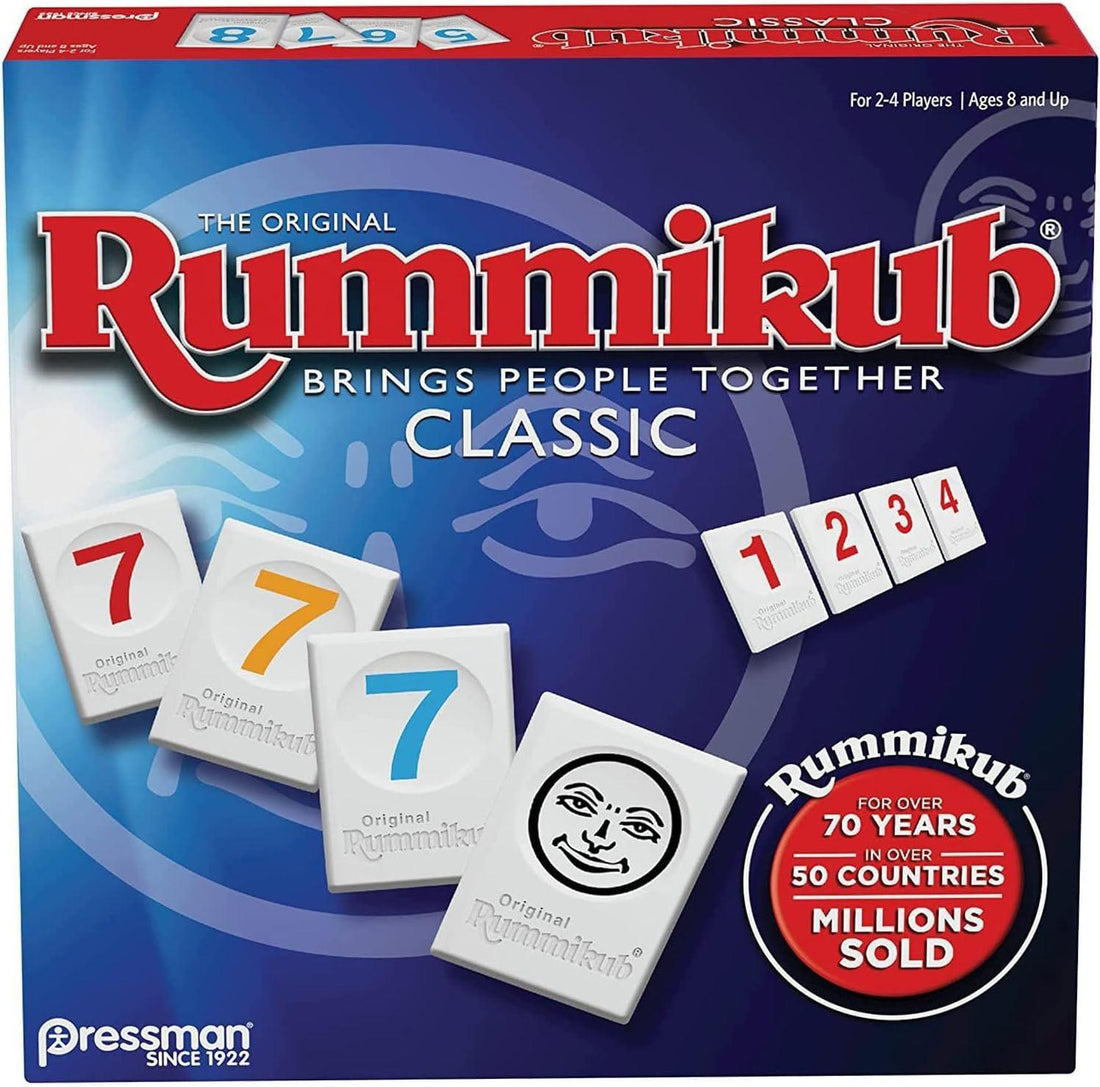
Rummikub (Rummikub) is a timeless board game using numbered and colored tiles. In this article, we'll introduce the basics of how to play the game, its appeal, things to be careful about, and who it's recommended for. If you want to learn more about Rummikub and have more fun, be sure to read on.
Game Basics
Rummikub is a tile-based game for 2 to 4 players . It is also known as Rummi or Rummy. It is suitable for players around 7 years old and takes 20 to 90 minutes to play.
The game has been described as a simple, fast-paced, and fun game that doesn't rely entirely on randomness, and as a popular tile game that combines elements of rummy and mahjong.
The goal of the game is to get rid of all the tiles in your hand . The player who gets rid of all the tiles in their hand wins the round and declares "Rummy Cube."
The game uses numbered and colored tiles that you combine into combinations called "sets" and "runs."
A set consists of three or more tiles with the same number but different colors . A run is three or more tiles with the same color and consecutive numbers .
It also includes two wild cards called "Jokers," which can be used to substitute for any tile.
To set up the game, first shuffle all the tiles face down in the center of the table.
Each player draws one tile, and the player with the highest number takes the first turn. After shuffling the tiles back, each player draws 14 tiles and arranges them on their own "rack." The remaining tiles become the "pool."
On your turn, you create a set or run with the tiles in your hand and place them on the table. However, when you first place tiles on the table, you must play a set or run with a total of 30 points or more at once as the "Initial Meld."
In this first play, you must only use the tiles you have in hand and cannot use or change tiles already on the table .
Players can also agree in advance whether or not they will be able to use jokers in this first play.
After you have completed your first play, you can take one of the following actions on your turn:
- Create new sets or runs with the tiles you have and put them on the table.
- Add your tiles to another player's set or run that is already on the table .
- Manipulate existing sets and runs on the table . This involves splitting and rearranging existing sets and runs and combining them with tiles in your hand to create new valid sets and runs. The "split and merge" technique allows you to make better use of the tiles in your hand by splitting a set and combining it with other tiles on the table to create new combinations.
When manipulating tiles, only legal sets or runs must remain on the table at the end of your turn, and no incomplete sets or leftover tiles may be placed on the table. Additionally, tiles that have been placed on the table cannot be returned to your rack.
If you cannot make a valid play on your turn, or choose not to play, you must end your turn by drawing a tile from the pool. The drawn tile cannot be played during that turn .
Play time is limited, sometimes to a maximum of two minutes per turn, and sometimes to around 30 seconds in timed variants.
If you exceed the time limit, you may end your turn by drawing a penalty tile. If you make an illegal play, you must also replace the tiles and draw three penalty tiles.
The round ends when one player has lost all of their tiles and declares "Rummy Cube." For scoring, the winner of the round receives a positive score equal to the total points of the tiles remaining in the hands of all other players.
The other players lose the total points of the tiles remaining in their hand as negative points. The point value of a tile is equal to its numerical value.
Jokers are worth the same points as the tile they represent, but may incur penalty points if they remain in your hand at the end of the round (for example, if another player gets Rummikub, a Joker in your hand is worth -30 points).
The game is played over a predetermined number of rounds (usually 3-5), and the player with the highest total points wins.
The appeal of Rummikub
Rummikub has multiple appealing features that make it loved by people of all ages: its simple yet deep strategic nature, its pleasant tactile experience, its functionality as a communication tool that transcends generations, and the fun of flexible operation.
Appeal 1: Simple rules and deep tactics
Rummikub is a game with simple rules yet surprising depth . This balance is one of the reasons why it is enjoyable for beginners and experienced players alike. The game rules are easy to explain, and it combines uncomplicated game flow with strategic thinking.
Particularly fascinating is the manipulation of tiles on the table, described as a "wonderful dance of numbers" and an "activity" in which you "pinch," "poke," and "peck" tiles to reduce your hand. At the start of the game, your decision-making options are limited, but as you progress, they increase to a "dizzying array of choices and opportunities."
Attraction 2: The feel of the tiles and the gaming experience
One of the attractions of Rummikub is the tactile feel of the tiles . They have been described as "tiles that make a pleasant clattering sound," referencing the "tactile" nature of the game. Some reviewers have expressed their appeal to the game's playability, saying that the beige rectangular tiles "feel like a lovely dance of numbers pressed into the beige." Reviews of the digital version also mention the ease of placing the tiles, suggesting the enjoyment of touching the physical tiles.
Charm 3: A communication tool that transcends generations
Rummikub is a timeless classic game with the power to "bring family and friends together across generations." The box's claim that it "brings people together" is felt to be "true." One reviewer mentioned that his entire family (ages 13 to 83) were able to play together over Christmas, saying, "That's kind of amazing."
The game itself, "more of an activity than a game," provides an "excuse" to bring people together around a table and a way to "spend quality time with loved ones." It's simple, "easy to sit down, incredibly easy to teach, and addictively fun," yet also functions as a tool for deepening relationships.
Appeal 4: Adaptability and fun to operate
A key aspect of the Rummikub gaming experience is the ability to manipulate existing sets and runs on the table , with the statement that "as the game progresses, it is crucial to remain adaptable and take advantage of existing sets on the table."
Looking for opportunities to add or remove tiles to create new combinations is a strategy to free up tiles in your hand and make your opponent unpredictable. The "split and combine" technique is a powerful way to put more tiles into play by splitting a set in two or manipulating an existing set to combine with tiles in your hand. In the Rummikub Sabra variant, this rearrangement and modification of the sets is described as "particularly dynamic and strategic," enabling additional tactics. While there is an element of luck involved in tile draws, the ability to rearrange the tiles on the table adds tactical depth to the game.
Disappointments and points to note
While Rummikub is appealing, it also has some drawbacks and points to be aware of, such as the element of luck, downtime, and issues with the rules and operability.
The first is that it relies too much on luck . Winning or losing is often determined by drawing numbers, and some people feel that it's more of an activity than a game. However, others argue that this mild reliance on luck levels the playing field, allowing even those who aren't the best at the game to win.
The second point is that there is "considerable downtime." This is because it takes time to "clean up all the tiles in the box and then deal them again" after the end of a round. However, some see this as "a feature, not a bug," and as a time when "people can have a friendly chat about the game."
There has been some discussion about the "hoarding" strategy, noting that it can be "boring" for other players. However, some have argued that hoarding is a "perfectly legitimate strategy" and that "winning against hoarders is the most fun."
Recommended for:
Rummikub is a game that is suitable for a wide range of players, and is especially recommended for:
- Board game beginners and families : The rules are simple and easy to understand, and children from around the age of 7 can play, making it suitable for people playing board games for the first time or those looking for a game that the whole family can enjoy.
- For those who also enjoy strategic thinking : Even within the simple rules, there are strategic elements such as how to use the cards in your hand and how to manipulate the tiles on the table.
- People who like the feel of tiles and physical components : The sound of the tiles clanking and the tactile enjoyment of actually manipulating the tiles.
- Looking for an opportunity to get together with family and friends ? The game itself is a great opportunity to gather around the table and spend some quality time with loved ones.
- People who can tolerate a moderate element of luck : There is a certain element of luck involved in drawing tiles, but this creates a chance for even people who are unfamiliar with the game to win.
- Test your quick thinking : Time limits add a new level of excitement to the game by forcing you to make quick decisions under pressure.
Rummikub is a classic tile game with simple rules that are easy to learn, and the fun of creating sets and runs with tiles and manipulating them on the table . It's a game that can be enjoyed by many generations and is a great opportunity to bring family and friends together.
Some reviews point out that the game has a strong element of luck and that there are downtimes, but these can also be seen as an opportunity to deepen communication between players and help bridge the gap in skill.
Opinions are divided, but this may be because it places emphasis not only on its strategic game aspect, but also on its value as an "activity" and its power to bring people together.
Simple yet strategic, and most importantly, a game that deepens connections with people, Rummikub is a worthy addition to your board game collection.
Check out Rummikub now and have fun with your loved ones!
Purchase Link
Free shipping throughout Japan. Orders placed before 3pm will be shipped the same day.Link to the official rules video
References and citations for this article
- "How to play Rummikub" video from the YouTube channel "Triple S Games"
- "Remember Rummikub?" video from YouTube channel "Shut Up & Sit Down"
- "Rummy Cube Spielregeln: einfach erklärt - Schweizer Jassverzeichnis"
- "Strategies and Tips for Winning at Rummikub - Ask.com"
- "Zijn er strategieën die je me leren? : r/rummikub"
- "Rummikub Digital Edition Review"

